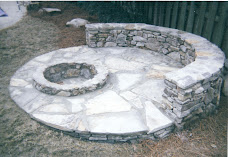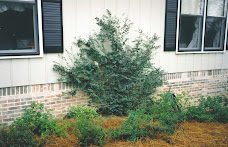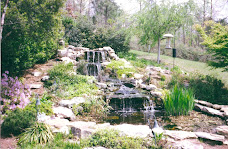Tuesday, November 19, 2013
Outdoor Fireplace Using Veneer Cast Stone
Posted by
themanfromearth
at
8:50 PM
3
comments
![]()
Labels: outdoor fireplace, stone work
Sunday, December 16, 2007
Got wood?

A half cord of fire wood
Are you fortunate enough to own a fireplace? If you do, you may have wondered, “what is the best wood to burn in my fireplace?” I have always heard that you don’t burn pine (and I was surprised at what I learned) or other conifers, as well as not burning wood that isn’t dense, such as sweet gum, hackberry, or mimosa. Which woods contribute more to creosote build up? Are certain types of wood better heat providers?
I decided to do a little research and answer some questions and maybe disprove some myths. 
Me, at home on the hearth!
1. The most important thing to know about the wood you use isn’t what type of wood it is, but that it’s properly seasoned. What is properly seasoned wood? The answer is, split wood that is at least a year old and is dry.
2. How do I know the wood I’m buying is really seasoned? Truly seasoned wood is dark or gray when you compare it to green wood, but when you split it; it is white on the inside and brittle or gnarly looking.
3. Fresh (green) wood is full of moisture, which makes lighting a fire very difficult. The excess moisture in wood is what contributes the most to creosote build up in your chimney flues, because the moisture creates smoldering, which leads to having a cooler flue surface, and thus, causes the carbon particles in the flue gases to solidify and condensate (this condensation is called creosote).
4. Is pine, cedar, and other conifer wood bad for your fireplace? Actually, these soft woods are not bad for your fireplace, as long as they are well seasoned. Conifer wood will actually burn hotter and cleaner than most hardwoods, such as oak, hickory, or poplar. The downside to burning conifer wood is that they are not dense woods, so they will burn quicker, which means you are cutting and splitting a lot more wood for the same amount of heat that a hard woods will put out. Personally, I don’t think I can bring myself to burning pine or any other conifer in my fireplace, based on years of warnings from my dad and grandpa, and since there is no shortage of good hardwood, I’d stay away from pines and the like.
5. So, what are some good woods and bad woods to use in my fireplace? Good, dense hardwood to use is oak, hickory, walnut and maple. Bad woods would include hackberry, sweet gum, mimosa and white oak.
6. Manfromearth, can you give me an overview for burning wood in my fireplace? Sure. Glad you asked! Buy well seasoned wood (split, dry, and at least a year old). The wood you buy on the side of the road just might be green wood, so consider buying wood this year to burn next year! Look at the trunks of a few oak trees and maple trees, and also a sweet gum tree, before going to buy wood. You may do yourself a favor by being able to tell if the seller is trafficking good wood! Try to keep your wood dry, but don’t wrap your wood stack up in a tarp. You want air to circulate around the wood so condensation doesn’t build up, like it would under a tarp. The wood you cut and split or buy, already split, should be at least a year old and will remain burnable (if it stays dry) for up to 4 to 5 years. 
A dry stack (untarped) of split wood
Posted by
themanfromearth
at
7:37 PM
1 comments
![]()
Labels: firewood, outdoor fireplace

































